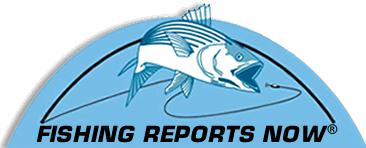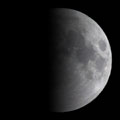| Saltwater Fishing Year in Review Part Four: Fall Fishing, the Year's Climax |
|
By Mark Marquez II |
|
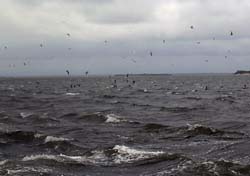 Ah, the fall ... nor'easters, stiff seas, and blitzing stripers and blues under working birds. Photo this past fall by Reel Fantasea Charters, Barnegat Light. |
The final article in a series about the 2007 saltwater fishing season, according to the fishing reports. Fluke season was closed in early September, earlier than past years, so fluking, normally a mainstay in the ocean in October, was not an option in the beginning of autumn. Striped bass were poised to migrate south through local waters, so fishing was somewhat in limbo. But this was a period of quiet before all hell broke loose. |
Waters were warm and in the 70s, too warm for the migration. But seas were warm enough for false albacore to push close to land, and albie fishing went off at the mouth of Raritan Bay toward Coney Island. Anglers intercepted them on light tackle and fly rods, connecting by sight casting when the speedsters popped up and broke the water surface, chasing bait. Bonito, another warm-water fish, also swam toward the coast, sometimes appearing in the surf for lucky anglers around Manasquan Inlet, and also at the ocean lumps nearby. This was one of those fortunate years for bonito anglers here. Bluefish were the name of the game for much of October, especially in Raritan Bay. But boats that would normally fluke fish at this time often bottom fished for sea bass and porgies. In South Jersey anglers often chased croakers and weakfish along the ocean front. |
|
Yellowfin tuna bit at night at the canyons, but catches started to become sporadic for the first time this season, an earlier peak than some years. But lots would continue to be battled through October, until waters finally cooled. Small bluefin tuna also started showing up at the inshore spots like the Mudhole early in the month, a good number of those fish compared with some recent years. Blues were also chasing mullet up and down the coast in the first days of October, and the mullet, much more numerous this year than in some time, were beginning to thin out. But peanut bunker were stacked up in the bays and were about to take the mullets’ place in the suds. |
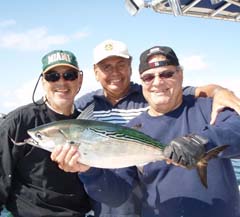 False albacore put up lots of fights at the mouth of Raritan Bay for Frenzy Fishing Charters, Staten Island, in October, one of Frenzy's specialities in fall. Photo from Capt. Tommy Verderosa from Frenzy. |
Baitfish were especially abundant this season, and anglers kept talking about the large amounts in the bays in the summer, hoping they’d eventually fill the surf and ocean front and make fall fishing great. Even sand eels would later show up in the surf and ocean in larger numbers than past years. New York’s blackfishing season opened in early October, but waters were too warm for a good bite. Jersey’s blackfishing bag limit wouldn’t increase to eight till mid November, and the limit was still one per angler. The increase in Jersey would be like the opening of blackfishing season in the Garden State. So time would remain before blackfishing kicked in. Weakfish kept hitting in Barnegat Bay in early October after a good season for the trout there, and weaks started tearing up waters around Absecon Bay, a later start to weakfishing than in most of the state, as usual. Everywhere else the weaks were trickling out of the bays and schooling to the ocean. Weaks were biting in the ocean along the beaches in the beginning of October, and so were croakers. Lots of kingfish roamed the surf at Atlantic City. A big nor’easter rolled in during mid October, and anglers finally anticipated cooler water and a change in fishing. They were right. Things were heating up afterward, one tackle shop reported, and peanut bunker now poured out of the bays. Some steady catches of short stripers were beached from the surf, mostly in North and Central Jersey but also in South Jersey like at Ocean City, and blues were also attacking in the suds along the whole coast. The cooler water was also picking up blackfishing for the New York boats. |
|
The canyon waters were chilling down to the high 60s in the middle of October, but tuna fishing there was sometimes on fire for both yellowfins and longfins. Bluefin tuna fishing for 35-pounders was ridiculous at the Monster Ledge on live peanut bunker, one charter captain said. Rough weather was coming through frequently, forcing lots of trips to be cancelled, but also chilling the water. Bluefishing was still excellent in the ocean, and big porgies and small sea bass kept bottom fishers busy. Panfish like baby sea bass, small porgies, kingfish and blowfish were holding in waters from Great Bay to the Wildwood back bay and nearby. Cooler water would push them out, so bait dunkers could hook stripers there instead of the panfish. But the resident stripers were still smacking popper lures in the South Jersey back bays. The water was warm enough. Small stripers also hit lures like soft plastics at places like the Manasquan River. |
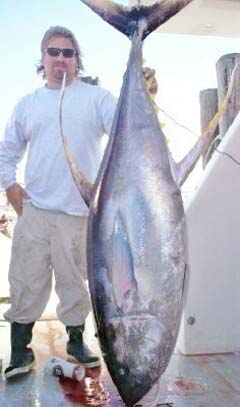 A 210-pound Allison tuna nailed on the party boat Gambler from Point Pleasant in October. |
By three quarters of the way though October, false albacore were starting to disappear from the mouth of Raritan Bay, and bonito were no longer being hooked in the ocean toward Manasquan Inlet. Also at this time, some weakfish were mixed in with panfish in Barnegat Bay. A body of large weaks suddenly showed up near the Verrazano Bridge at Raritan Bay and stayed for a time, even though a short-lived weakfising season had already come and gone in the bay earlier. In late October another nor’easter, three days of rains and winds, slammed the coast. “Finally,” a charter captain from Barnegat Bay said in a report during the blow. His charter nailed a 31-inch striper and a 35-incher and missed other striper bites. “It’s time to fish, folks,” he said. In the next days he would report that a new body of stripers definitely moved in, and his anglers were bagging keepers in the bay on almost all trips. Absecon Bay and the surrounding area also started holding more linesiders. Tuna fishing had been going strong at the canyons from north to south, though some trips were a bust. But by November 1 cold water was dominating, and one charter captain declared the season finished. Some boats would keep going, especially party boats, but the end was near. “We got bass!” a Seaside Park surf-fishing shop reported in the first days of November. Eighteen stripers were weighed in from the suds that day. |
|
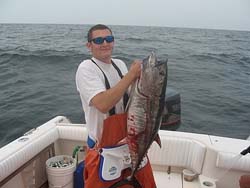 Bluefin tuna turned on during fall around the Mudhole, and Andrea's Toy Charters from Point Pleasant was swimming live peanut bunker to catch them. This trip went 6 for 7 on the speedsters at the Monster Ledge. |
“It started,” another report from a Great Bay tackle shop said in the first days of November. Clamming for stripers turned on for boaters at Little Egg Inlet, not full-swing, but sometimes good. Bunker chunking for stripers in Delaware Bay was beginning, but mostly blues schooled the Cape May Rips. Sand eels began appearing, and stripers started being jigged in the ocean in the northern half of the state, but they were also clammed. Only a few stripers swam South Jersey’s ocean. But blues were there, and stripers kept hitting lures in the southern state’s bays. |
Blackfishing was very good for New York boaters by the second week of November. Jersey bottom-fishing boats were scoring good catches of big porgies and sometimes sea bass. Some who fished farther from shore were also picking up ling for a little while already. By this time, the middle of the eleventh month, surf fishing for bass and blues was taking off in North and Central Jersey, right on schedule this year. That was almost surprising, because of the warm fall, but cooler weather suddenly settled in. Bluefishing in the suds was good in South Jersey, but the stripers would take a moment to trickle down. Manasquan Inlet charters were jigging good catches of stripers and blues in the ocean in mid November. Raritan Bay anglers were still mostly finding blues but sometimes a mess of small stripers and occasional keepers. The ocean was in the mid 50s now. Jersey's blackfish bag limit increased to eight fish from one on November 15, and catches were good in the ocean up and down the coast. Some charter boats began to call it a season by Thanksgiving, mainly because their charter insurance expired in December. |
|
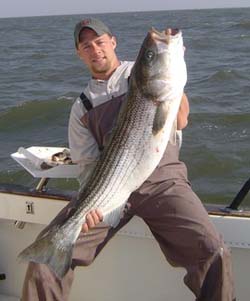 The main event. Striped bass would finally start biting in a big way in November, pushing fall fishing to a climax through the month. Jaftica Sportfishing from Cape May got into some of the first catches of linesiders including this one in Delaware Bay early in the month. |
Delaware Bay’s stripers were actively sucking down bunker chunks, and the Cape May Rips were now turning on for the bass on live bait. But cold, windy, unsettled weather was taking hold, and one tackle shop decided to close for the season, the first store that reported closing. Another shop said diehard anglers hit the surf in Central Jersey and connected. Lots of stripers were still around, but by the beginning of December blues mostly disappeared, heading for warmer climates. At least one party boat was already running offshore for wreck fishing for jumbo sea bass. A sign of winter coming. |
Snow fell in early December, and air temps plummeted into the teens, an early cold spell that would put the kibosh on much fishing participation. Shops were reporting scarce anglers, an earlier disappearance than recent years. Ironically stripers kept biting, but few hardy anglers were taking advantage. A Sandy Hook party boat reported excellent jigging for stripers. “You wait all year for this,” he said. Lots of keepers were hauled aboard. Stripers kept biting clear down to Cape May, but many Cape May charter captains now pulled their boats from the water, often simply because the marinas were closing for the season. Many anglers were taking boats out of the water for the year in early December. |
|
During the second week of December, Delaware Bay’s water temp dropped into the 30s, and stripers high tailed to the ocean. By mid December a Seaside tackle shop said surf fishing was 99.9 percent finished. But good catches of stripers occasionally appeared anywhere from the Shrewsbury Rocks up north to the ocean off Long Beach Island to Ocean City down south. Still, some areas, including Absecon, said most stripers were now beyond 3 miles from land, where striper season was closed. The fish were seeking warmer water. |
 Tog fishing became much of the focus in December and January. This slippery was one of many reeled up on the Stray Cat from Longport, a few towns south of Atlantic City, in December. |
Striper fishing was finished. Mackerel appeared at the end of December, like the fat lady singing. The Bostons are the first to migrate north in spring and the last to migrate south in winter. South Jersey tackle shops in early January were reporting good white perch fishing at places like Collins Cove on the Mullica River, a traditional winter fishery. Warmer weather was reappearing, and forecasts called for 60-degree temps. Tog fishing was now a main event and was good, although the bag limit dropped to four of the fish from eight at the first of the year. Bottom-fishing boats were also targeting ling inshore, and cod catches were better than usual on those vessels. Offshore party boat fishing for jumbo sea bass was practially the only other choice for saltwater anglers, and sea bass seemed smaller than in the past, but they were biting. By today, February 8, tog fishing has slowed down, and the options are limited to bottom fishing for ling and cod at the inshore spots or heading far offshore for sea bass and such. The fishing is decent, not always great, but all right. And the wait was on for the opening of striped bass season March 1 in the bays and rivers. |
|
|
|
